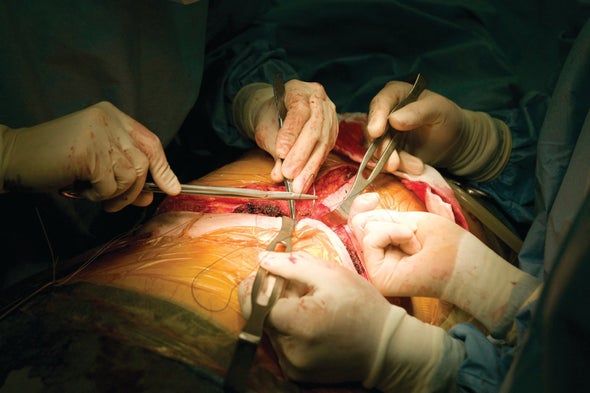More than 1,000 people in the U.S. died while waiting for a liver transplant in 2018, partly because standard preservation methods can keep a donor liver alive outside the body for only about 24 hours. But now, in a feat of medical engineering, scientists have developed a machine that can keep a liver functional for a week or more. It has not yet been used for human transplants, but the technology represents a leap forward in the field of organ preservation.
Many donor livers do not meet the criteria for transplantation, because they are too old, contain too much fat or have been damaged (by cardiac arrest, for example). Researchers say the new device could keep livers alive long enough to repair themselves—something they can do to some extent in the body—and give doctors time to better assess the organs' condition. “We decided to [study the livers] for one week because this is the amount of time you need for a liver to regenerate” in patients who have had part of the organ removed, says Pierre-Alain Clavien, head of surgery and transplantation at University Hospital Zurich and senior author on a paper describing the research. He says this preservation technique could especially benefit some liver cancer patients, who could have noncancerous portions of their own livers kept alive for later reimplantation to circumvent problems related to tissue rejection.
The standard method for preserving donor livers is flushing them with a cold solution and putting them on ice, where they can remain viable for 12 to 18 hours. Recently scientists developed a method of cooling livers without freezing them, which can extend that time to 27 hours. But this is still not long enough for an injured liver to repair itself, Clavien says.
The new machine buys crucial time by mimicking key features of the human body. The setup pumps blood through the organ—a process called perfusion—at carefully controlled pressures and oxygen levels. A sugar solution provides energy to red blood cells going through the liver, and the hormones insulin and glucagon are injected to maintain glucose levels. A dialysis unit removes wastes and keeps electrolytes in balance. And an inflatable balloon positioned under the liver replicates the movement of the diaphragm during breathing, which prevents tissue damage from constant pressure on the organ.
The researchers developed and refined their device using pig livers before trying it with human ones. They managed to preserve a total of eight healthy pig livers for one week and successfully transplanted three into live pigs, which survived the surgery. After transplantation the perfused livers showed levels of injury markers comparable to those of five livers that had instead been stored on ice for several hours before transplantation.
The team then tested the machine with 10 human livers that multiple European transplant centers had rejected because of the organs' poor quality. Liver damage can be measured by an increase in proteins called damage-associated molecular patterns (DAMPs); of the 10 livers in the experiment, six showed a decrease in DAMPs and other signs of damage after time in the machine. “We can now consider injured human livers for transplantation without endangering a patient life,” Clavien says. He and his colleagues described their work this past January in Nature Biotechnology.
“It's a very well-done study,” says Korkut Uygun, a surgeon and bioengineer at Harvard Medical School, who was not involved in the new research. “From a clinical perspective, [keeping livers alive] just a few extra hours will help.” The study's biggest limitation, Uygun says, is that only 60 percent of the livers remained stable after a week on the machine— if they were healthy livers, “a 40 percent failure rate is not acceptable in the world of transplantation.” Uygun is also not convinced the machine can actually enable liver regeneration as opposed to just preserving them. “Regeneration is a tough thing,” he says. “The potential is incredible, but we need more time to show this.”
The significance of the new findings can be summarized in one word: time, says Stefan Schneeberger, head of transplant and hepatobiliary surgery at Innsbruck Medical University in Austria. “It's the first example of technology allowing for preservation of an organ for a week. That is kind of a milestone,” says Schneeberger, who was not involved in the study. He says there is not much evidence that the machine can improve the quality of the livers, and actual “regeneration” is likely further off—but it remains the ultimate goal.
Although the results are promising, the researchers have yet to demonstrate the preserved livers' long-term functionality. The next step is to perform transplant survival experiments in large animals, Schneeberger says. If those experiments are successful, they will make more livers usable for transplant into human patients who have low priority on waiting lists—and Clavien says this could happen as early as this year. In the future, he adds, the new machine could theoretically be used to preserve other organs such as hearts or kidneys.

